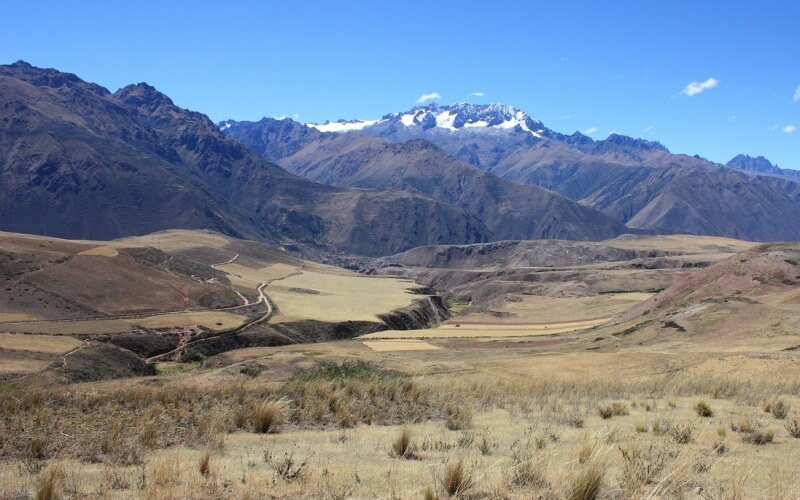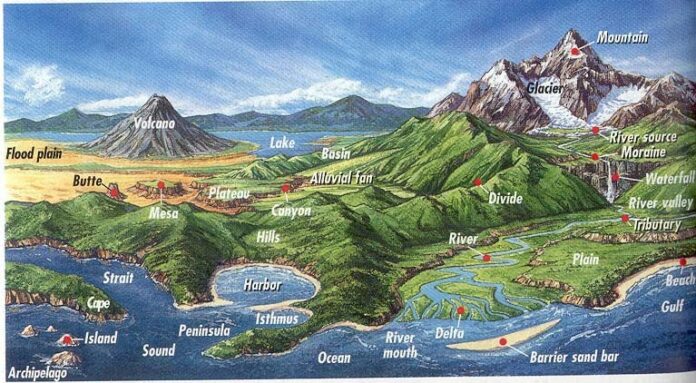Introduction
Welcome to a captivating journey through the diverse and extraordinary landforms that adorn our planet’s surface. From majestic mountains to winding rivers, from vast deserts to lush valleys, the world’s landforms offer a spectacular tapestry of natural beauty and geological wonders. In this article, we will delve into the fascinating realm of landforms, exploring their formation, significance, and the awe-inspiring landscapes they create.

Unveiling the Diversity of Landforms
Landforms encompass a wide range of geological features that have been shaped by natural processes over millions of years. Each landform tells a unique story, reflecting the dynamic forces of nature and the intricate interplay of Earth’s processes. Let’s embark on a journey to discover the diverse types of landforms that grace our planet.
- Mountains: Majestic Peaks Touching the Sky
Mountains are awe-inspiring landforms that punctuate landscapes with their towering presence. These majestic peaks are formed through tectonic forces, such as the collision of tectonic plates or volcanic activity. Mountains not only offer breathtaking vistas and recreational opportunities but also serve as crucial habitats for diverse flora and fauna.
- Valleys: Nature’s Sculpted Grooves
Valleys are low-lying areas often surrounded by mountains or hills. They are formed through various geological processes, including erosion by rivers, glaciers, or tectonic activity. Valleys create stunning landscapes, providing fertile ground for agriculture, human settlements, and natural habitats for a wide array of plant and animal species.
- Plateaus: Elevated Vistas of Flatlands
Plateaus are elevated flatlands that stretch across vast areas. They are created through geological processes such as volcanic activity, uplift, or erosion. Plateaus offer panoramic views of expansive landscapes and are often characterized by unique ecosystems and geological formations.
- Deserts: Arid Landscapes of Contrasting Beauty
Deserts are vast areas of land characterized by low precipitation and arid conditions. They come in various forms, including sandy deserts, rocky deserts, and icy deserts. While deserts may appear barren, they are home to resilient plant and animal species adapted to survive in extreme conditions. These landscapes exhibit a unique beauty, with stunning sand dunes, rock formations, and captivating sunsets.
- Canyons: Nature’s Masterpieces of Erosion
Canyons are deep, narrow valleys carved by the erosive power of rivers over millions of years. They create breathtaking landscapes, with towering cliffs, winding rivers, and dramatic rock formations. Famous examples include the Grand Canyon in the United States and the Fish River Canyon in Namibia.
- Plains: Expanses of Open Terrain
Plains are vast stretches of flat or gently rolling land, covering extensive areas of the Earth’s surface. They are formed through various processes, including sediment deposition, erosion, or tectonic activity. Plains offer fertile soils, making them ideal for agriculture and human settlements. They are often characterized by grasslands, savannahs, or agricultural fields.
- Water Bodies: Lakes, Rivers, and Oceans
Water bodies, including lakes, rivers, and oceans, are vital landforms that shape the Earth’s surface. Lakes are inland bodies of water, often nestled in valleys or formed by glaciers. Rivers meander through landscapes, carving valleys and transporting sediments. Oceans, covering the majority of the Earth’s surface, are vast bodies of saltwater, hosting diverse marine life and driving weather patterns.
Frequently Asked Questions (FAQs)
FAQ 1: How are mountains formed?
Mountains are formed through tectonic processes, primarily by the collision of tectonic plates or volcanic activity. When two plates collide, the crust crumples and uplifts, creating mountain ranges. Volcanic mountains, on the other hand, are formed by the accumulation of volcanic materials over time.
FAQ 2: What causes the formation of valleys?
Valleys are formed through various geological processes, including erosion by rivers, glaciers, or tectonic activity. River valleys are carved by the erosive power of rivers over time, while glacial valleys are shaped by the movement of glaciers. Tectonic activity can create valleys through the uplifting or faulting of the Earth’s crust.
FAQ 3: Are deserts lifeless?
Contrary to popular belief, deserts are not entirely lifeless. While they may have harsh conditions, deserts support unique ecosystems with specially adapted plant and animal species. From cacti and succulents to camels and desert foxes, deserts are home to a surprising array of life that has evolved to thrive in arid environments.
FAQ 4: How are canyons formed?
Canyons are formed through the erosive power of rivers. Over millions of years, flowing water gradually carves deep and narrow valleys, resulting in the formation of canyons. The erosive forces of the river, coupled with the underlying geology, shape the dramatic cliffs and rock formations that define canyons.
FAQ 5: What is the significance of water bodies?
Water bodies play a vital role in shaping the Earth’s surface and supporting life. Lakes provide habitats for diverse aquatic species, offer recreational opportunities, and serve as water sources for surrounding ecosystems. Rivers transport sediments, create fertile floodplains, and sustain freshwater ecosystems. Oceans, covering the majority of the planet, drive weather patterns, host a myriad of marine life, and play a crucial role in regulating the Earth’s climate.
FAQ 6: How do landforms contribute to the overall beauty of the Earth?
Landforms contribute to the overall beauty of the Earth by creating diverse and visually captivating landscapes. From the majestic peaks of mountains to the tranquil serenity of lakes, each landform adds a unique element to the grand canvas of nature. The contrasting textures, colors, and formations of landforms create breathtaking vistas that inspire awe and appreciation.
Conclusion
Landforms are the geological masterpieces that adorn our planet, shaping its surface and creating stunning landscapes. From the towering peaks of mountains to the winding canyons carved by rivers, each landform tells a story of the Earth’s dynamic forces and processes. By exploring and appreciating these wonders, we gain a deeper understanding of the remarkable diversity and beauty of our world.
============================================


